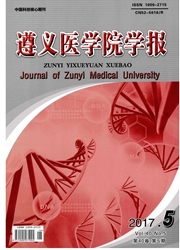

 中文摘要:
中文摘要:
目的体外分离培养人肉芽组织、1年及2年增生性瘢痕不同时期的成纤维细胞,探讨其成骨、成脂、成软骨分化潜能,为创面修复治疗提供新的供体细胞来源。方法采用机械法结合酶消化法分离培养肉芽组织、1年及2年增生性瘢痕成纤维细胞,倒置相差显微镜下观察细胞形态及增殖情况,并绘制成纤维细胞的生长曲线。免疫细胞化学法检测Vimentin和CK19的表达。通过向成骨、成脂、成软骨细胞诱导分化鉴定多向分化潜能。结果成纤维细胞主要以长梭形为主,呈放射状、旋涡状生长;肉芽组织成纤维细胞增殖活力最强。三种来源的成纤维细胞均表达Vimentin,不表达CK19,经诱导可向骨、脂肪、软骨细胞方向分化。结论人肉芽组织到增生性瘢痕不同时期的成纤维细胞具有多向分化潜能,可作为创面修复治疗及组织工程研究的理想供体细胞。
 英文摘要:
英文摘要:
Objective To investigate the differentiation capacities of human fibroblasts derived from granulation tissue and hypertrophic scars in different periods into osteocytes, adipoeytes and ehondro- cytes and further provide new sources of donor cells for the wound repair treatment. Methods Fibroblasts derived from granulation tissue and 1 -year and 2 -year hypertrophic scars were isolated and cultured by mechanical method combined with enzymatic digestion method. The ceils morphology were observed under phase - contrast microscope and the cell proliferative curve was drawn. The expressions of vimen- tin and CK19 in isolated ceils were detected by immunocytochemistry assay. Multipotential differentia- tion capacities of isolated cells into osteocytes, adipocytes and ehondrocyte were identified. Results Pri- mary cultured fibroblasts isolated from different derivation were presented with spindle, polygonal and ir- regular shape. The proliferative capacity of the fibroblasts derived from granulation tissue was more po- tent than that from 1 - year and 2 - year hypertrophic scars. Immunoeytochemistry results showed that vimentin were positively expressed in fibroblasts from 3 derivation , whereas CK19 were negatively ex- pressed. Fibroblasts from different derivation were induced to differentiate into osteocytes, adipocytes and chondrocyte. Conclusion The fibroblasts from granulation tissue and hypertrophic scars in different periods possess multipotent differentiation capacities and thus could be used as an ideal donor cells for the wound repair treatment and tissue engineering study.
 同期刊论文项目
同期刊论文项目
 同项目期刊论文
同项目期刊论文
 期刊信息
期刊信息
